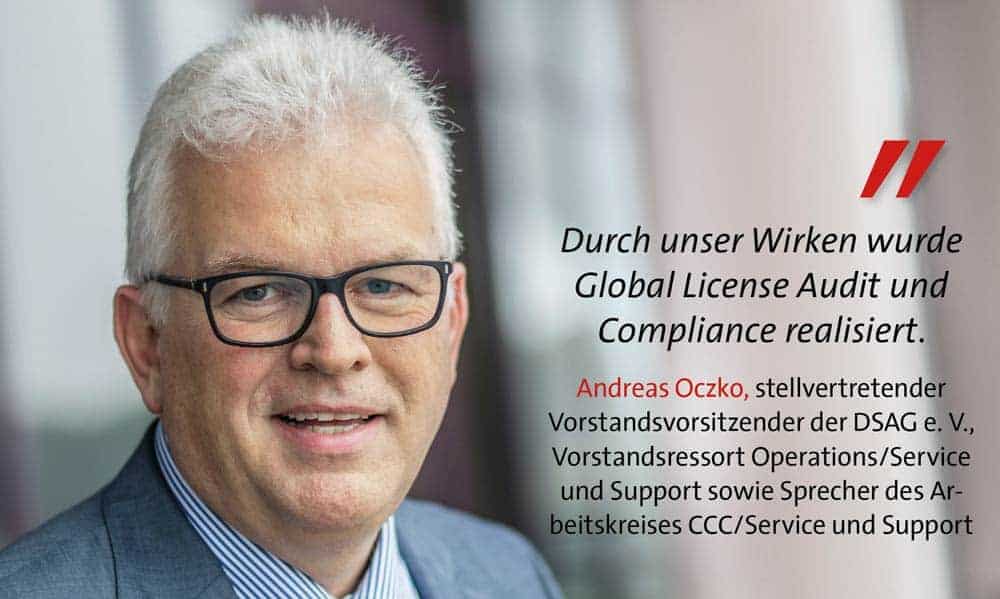Interoperability, antitrust and "indirect" use: Exclusive interview with DSAG board member Andreas Oczko


Gottfried Welz, E-3: Has there been any feedback from existing SAP customers regarding the indirect use license model presented in April?
Andreas Oczko, DSAG: DSAG conducted a survey on the topic of license model and indirect use. The feedback from 220 customers was important. Whereby we had expected the answers in this or similar form.
One result was that users perceive this licensing model very well. However, certain ambivalences became clear. It is therefore difficult for customers to know exactly how many documents are used or counted as the basis for licensing or indirect use under the model.
At present, it is even more difficult to determine how the model should be applied to complex business processes or system landscapes. Users are also still unclear or unclear on the subject of IoT and indirect use.
On the other hand, SAP has communicated that this model does not claim to solve all indirect usage issues. I think that the next year will remove a number of ambiguities.
Welz: How do existing customers currently determine the costs for the new indirect use? SAP does not want to present suitable surveying tools until 2019.
Oczko: As of today, there are very simple tools - rather checklists - that can be implemented or used. If things go well, you get document relevance. Otherwise, you are required to estimate. And to evaluate: Okay, this fits for me, or just no, it doesn't fit.
Auditing routines or surveying tools are not yet available. Even for older releases, these will probably not be available in the form of support packages until next year. This means that it will certainly be some time before tools are available and customers can use them.
Welz: What is the opinion of DSAG, will it be more expensive or cheaper with the new license model regarding indirect use?
Oczko: It can become cheaper for some customers - but also more expensive. It may also become unaffordable for some customers. The new licensing model should be seen as an option. No more, but also no less.
Welz: What is DSAG's position on the legal opinion that, due to EU copyright law, chargeable, indirect use is in conflict with interoperability? Is SAP subject to an error here?
Oczko: Interoperability does not in and of itself mean indirect use. But not every interaction of systems means interoperability. If, for example, inventories are transferred from a warehousing system to an SAP system, this does not constitute indirect use.
However, if a Salesforce application receives a sales order, transfers it to SAP, processes it there, and calls SAP functions in the ERP from Salesforce, this is of course an indirect use that requires a license and has nothing to do with interoperability.
Welz: What is DSAG's opinion on the Voice e. V. license report that was submitted to the Federal Cartel Office in Bonn? Nothing is currently known about this process. Does DSAG know the status at the Federal Cartel Office?
Oczko: I am not aware of any current or new developments. But I would like to ask: When does Voice think it will get a legally binding answer or receive one in concrete terms? That will take at least ten years.
But a company cannot wait ten years for a decision. For the current indirect use, the Voice initiative does not help. DSAG was involved before the submission to the Federal Cartel Office, and there was an exchange of views with Voice.
The association has decided to take legal action. We are working together with SAP to find a solution to the problem and are still in intensive talks with SAP.
Welz: Logically, the products of SAP companies such as Ariba, Concur, SuccessFactors, Fieldglass and Hybris are excluded from indirect use. But why is the SAP Hana Cloud Platform subject to Indirect/Digital Access in the new SAP licensing model, and thus to indirect use that requires a license? Doesn't SAP thereby also hinder intensive use of the SCP by its existing customers?
Oczko: SAP's approach here is incomprehensible and counterproductive. We have made this clear to SAP. There is also a need for clarification and a solution with regard to Abap use via SCP. After all, why should users pay for Abap developments that no longer run via a licensed on-premise workbench, but via SCP?
Welz: What ideas and actions will there still be from the DSAG to defuse the issue of indirect use - and thus possibly not block the digital transformation?
Oczko: As I said, the talks are ongoing. And we are not letting up. There was a last big workshop at the beginning of September, which was also attended by an SAP executive. There will be a workshop on interoperability in November. We have also launched a spin-off on related topics.
For example, on the topic of license audits. As the voice of the users, we see a high degree of urgency in the topic of indirect use and do not want to weaken the pressure on SAP in any way.
Welz: In addition to technical and organizational concepts, will DSAG also offer members legal assistance in the event of conflicts surrounding indirect use?
Oczko: Of course, we cannot provide legal advice here. However, we do cooperate with lawyers on this topic. To get a legal assessment and also security in the discussions with SAP. We make the results and the assessments of lawyers available to our members.
Welz: What is DSAG's opinion of SAP's Global License Audit and Compliance, GLAC?
Oczko: What is perhaps not so familiar: GLAC was realized through our work. As far as we know, GLAC works. Just the separation of functions or topics. ASUG, the American user association, also confirms this.
Welz: Thank you for the interview.
SAP Global License Audit and Compliance (GLAC)
In April of this year, SAP presented a new licensing model with the goal of bringing some clarity to the self-invented "indirect use". The easiest way would naturally be to recognize EU copyright law with the definition of "interoperability".
But then SAP would miss out on many millions in back license payments! Thus, there is a new model and the benevolent intention to professionally solve "disputes" with existing customers in the future.
SAP released the following statement in response:
"Clear separation between license sales and audit and compliance: SAP is also introducing new rules in organization and governance that provide for a strict separation between the sales organization and processes and the audit organization and its processes.
To this day, there are always differences between customers and SAP as to how older contracts are to be interpreted with regard to the new digital requirements. In some cases, this has a negative impact on parallel discussions on the acquisition of new software.
The organizational changes on the SAP side now allow these issues to be separated and enable independent discussions. This makes it easier for customers and employees from SAP sales to work together."
Now, according to SAP, there is a suitable organization: the GLAC team (Global License Audit and Compliance). And a "path of appeal" is also said to already exist.
E-3 author Florian Ascherl, Director Risk Advisory at Deloitte and Head of the Global SAP Licensing Competence Center, has summarized all the details.





